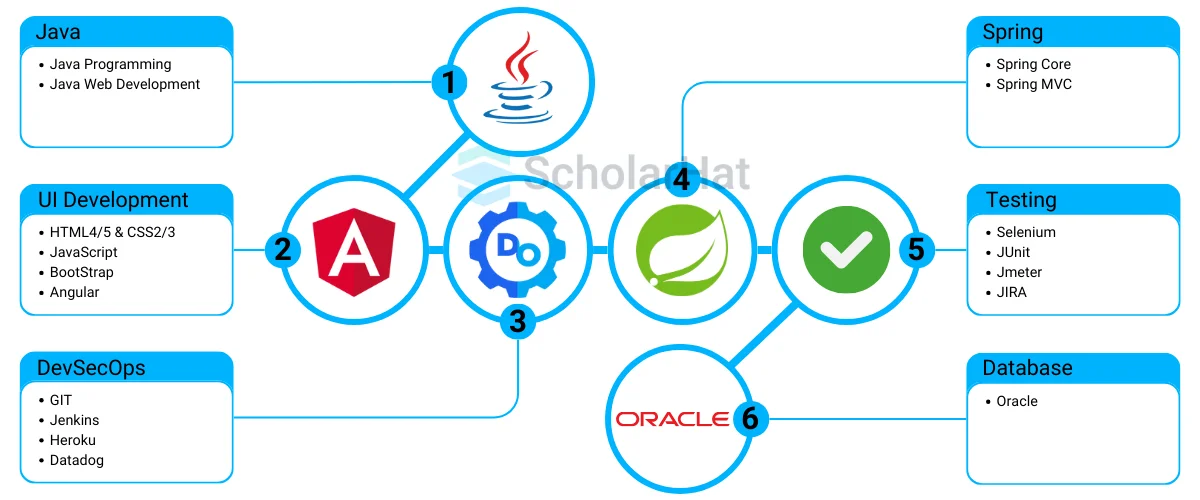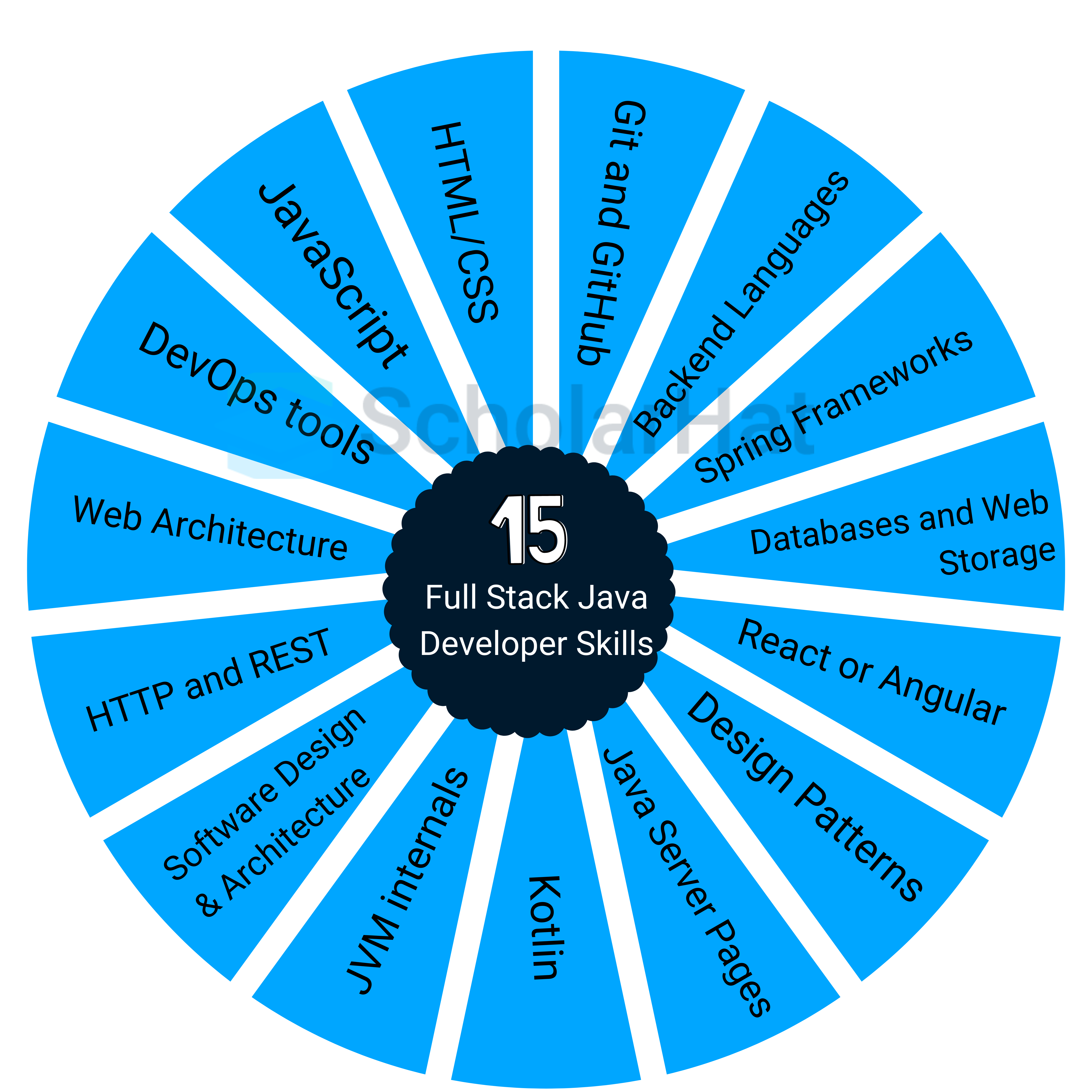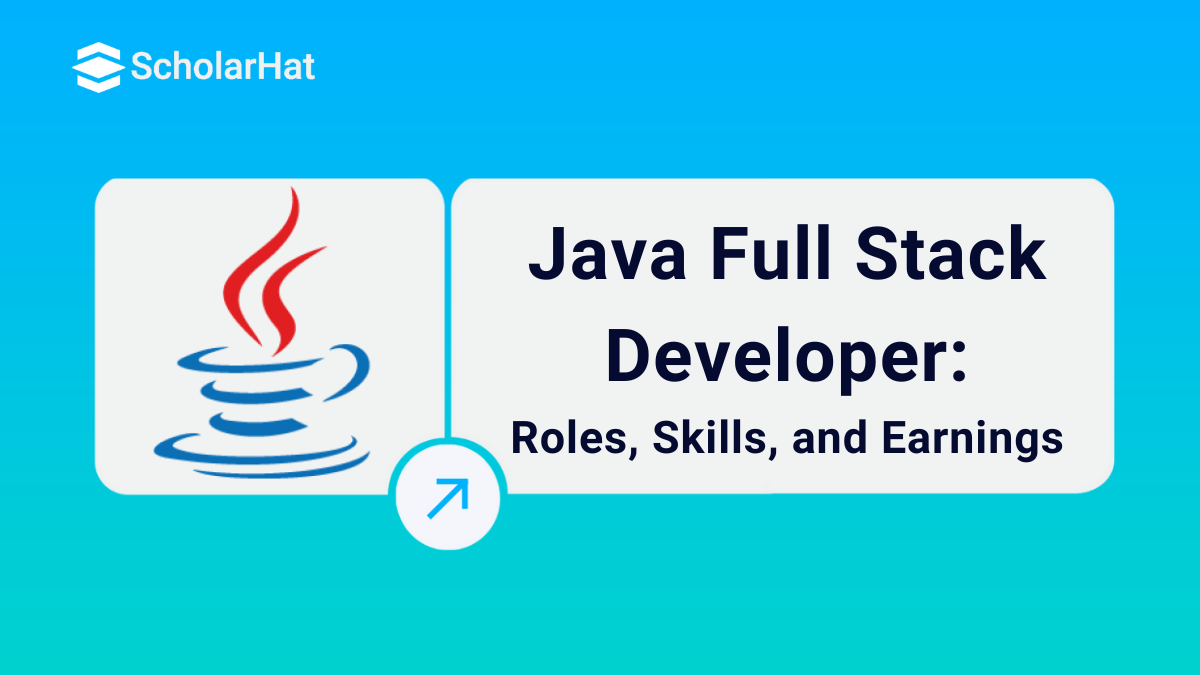18
Apr15 Top Full Stack Java Developer Skills
Java Full Stack Developer
A Java Full-Stack Developer is a software expert who is skilled in both front-end and back-end programming with Java and other technologies. They manage the full development process, from user interface design to server-side logic and database management.
In this Java tutorial, we will discuss skills, a roadmap, salaries, and interview advice. "Whois a Java Full Stack Developer?" is a good place to begin.
Ready to supercharge your career? chooseour Java Programming Free Online Course.
Who Is a Java Full Stack Developer?

- Java full-stack web developer is someone with the ability to create both client and server software.
- This means that full-stack Java developer skillsinvolve working on both the client and server sides of a software program.
- This style of developer works on the entire stack of a software product, starting with front-end development and progressing to back-end development, database, server, API, and version control systems.
- His extensive knowledge of the Java Full-stack framework and tools, such as Core Java, servlets, APIs, databases, web architecture, and others, is extremely beneficial in lowering project costs and shortening timelines because a full-stack developer can seamlessly switch between front-end and back-end development.
Roles and responsibilities of Java full-stack developers
- Full-Stack Java Developers act as conductors, making judgment calls on managing and directing the flow of information across different system components.
- They collaborate with designers, developers, project managers, and quality assurance engineers to create designs and products that meet or exceed client expectations.
- Responsibilities include developing and implementing software solutions with development teams and product owners, ensuring efficient client- and server-side architectures, and authoring visually appealing front-end applications.
- They must troubleshoot, debug, and upgrade software as necessary, employing strong security and data protection measures while also creating mobile-responsive features and detailed technical documentation.
- Essential frontend technologies include HTML, CSS, JavaScript, build tools like Babel, npm, and Webpack, and scalable UI frameworks such as Angular, React, and Vue, enabling the construction of user-friendly and responsive interfaces that integrate smoothly with backend services.

15 Best Full Stack Java Developer Skills
A Java developer is responsible fordesigning, creating, and maintaining Java-based programs. His skill set includes creating well-structured and created code that is suitable for thorough testing and analysis. So, the Java developer's main abilities are:

1. JavaScript
- A developer's understanding of JavaScript is required to integrate interactive features in web pages, such as timely information updates, interactive maps, and dynamic visuals.
- JavaScript frameworks such as React Native, Ionic, and Angular expedite development and simplify it.
- The virtual community created by Facebook uses React and React Native. In the industry of virtual reality, using JavaScript for developing web browser games is GitHub.
- Node.js is a runtime environment for loading server-side applications, free from the constraints of the browser.
- JavaScript, used for front-end development, makes it possible for the user to have an interactive interface which, in turn, supports features like drag-and-drop.
- So, it becomes very important for full-stack developers to be conversant with the JavaScript frameworks.
2. HTML/CSS
- The Java front-end developer must be skilled in HTML and CSS.
- HTML allows the structuring of documents in a web browser.
- It uses elements to wrap content and set up how it is displayed.
- CSS further explains what HTML elements look like, such as color, layout, and fonts, to make them compatible with different devices.
- That is the basic role of HTML: organizing data on a website, whether it be paragraphs, bullet points, or tables.
- Styling those elements with CSS will allow friendly, intuitive user interfaces.
- Together, HTML and CSS enable the creation of responsive websites and applications, which is absolutely necessary for front-end development.
3. Git and GitHub
- Java full-stack developers must understand both Git and GitHub.
- Git is an open-source version control system for managing changes in source code, recovering from crashes, and tracking file updates.
- It makes code review easier and helps manage big codebases.
- GitHub, a collaboration and version control website, provides Git repositories, allowing developers to work together from several locations.
- GitHub's public repositories enable social coding by allowing developers all over the world to interact with and improve each other's code.
- Mastering Git and GitHub is necessary for effective project management and collaboration.
4. Backend Languages
- A software development project's backend is the website's server side.
- It is the part of the website that neither the client nor the users can see.
- Users can access this section via the front-end application.
- As a result, the backend is where data is stored and arranged, and its purpose is to ensure that the client side of the website runs smoothly.
- Java backend developer talents would include command over APIs, library creation, and working with system components without user interfaces.
- Specific languages are used to build the backend of a website.
These include
- PHP is a scripting language used to manage the server side of web development. PHP is referred to as a server-side scripting language since it executes code on the server side.
- C++ is a computer language that is now utilized for competitive programming. Its adaptability allows it to function as a backend language.
- Java is the most popularlanguage for programming and platforms. It is also very scalable.
- Python is a very significant backend language since it helps developers work rapidly and integrate systems with few errors.
5. Databases and Web Storage
- Full-stack Java developers must have a thorough understanding of both relational and NoSQL databases.
- A database is a collection of structured and electronically stored data that is maintained by a Database Management System (DBMS).
- Relational databases, such as MySQL or PostgreSQL, use structured tables to store data, but NoSQL databases, such as MongoDB or Cassandra, handle unstructured data and have flexible schema.
- Another important feature is web storage, which allows data to be saved locally on the client's device.
- Unlike cookies, web storage does not expire and does not communicate data to the server, so it remains even when the browser is closed. This local storage approach improves the user experience by providing faster access to frequently used data.
6. Spring Frameworks
- This framework provides multiple choices for developers to manage business objects.
- It also simplifies web application development compared to traditional Java frameworks.
- To construct enterprise applications, the Spring framework combines a variety of innovative approaches,such as aspect-oriented programming, plain old Java objects, and dependency injection.
- Its compact nature makes it the best framework for Java EE7 developers looking to build simple and scalable enterprise apps.
7. DevOps tools ( Jenkins, Docker, and Kubernetes)
- DevOps technologies and approaches help to simplify project development processes.
- These are technologies that help simplify and automate manual processes, assist project teams in managing complicated settings of large-scale projects.
- Allow developers to keep a strong grip on the high velocity caused by the use of DevOps tools.
- The use of these tools speeds up the software development and delivery process significantly.
Jenkins
- When a project demands continuous and consistent integrations, Jenkins is the technology to employ.
- It simplifies the process for DevOps engineers to generate, test, and integrate the project's changes.
- This is a Java-based, open-source automation platform that includes plug-ins to aid in the smooth integration of changes within projects.
Docker
- Docker is a software platform that allows programs to be written, tested, and deployed without the waste of time.
- Docker provides standardized units of packaged software (containerized) that include libraries, system tools, code, and runtime to enable software to go live.
Kubernetes
- Kubernetes is an open-source technology, sometimes known as K8s, that automates application deployment, scaling, and management in containers that include everything needed to operate the program.
8. Web Architecture
- This is also one of the required skills for a Java full-stack developer.
- It refers to the process of developing, designing, and implementingcloud-based computer software.
- These programs usually appear on websites that provide route maps for users/developers to construct or develop programs for enterprises or companies.
- Web architecture will use and contain all application components required by web developers to construct apps that improve user experience.
- It involves key elements like design, technology, user experience, software, making money, efficiency, reliability, scalability, and security.
- A good web architecture is like a strong foundation. It ensures that the final product is high-quality, easy to change, and works well.
9. HTTP and REST
HTTP
- Understanding Java full-stack developer skills requires knowledge of HTTP. HTTP stands for Hypertext Transfer Protocol.
- It is the foundation of www or the World Wide Web.
- This networking or communication protocol facilitates the movement of information from one networked device to another.
- A typical situation would be a client computer requesting that the server transmit the appropriate information, followed by the server doing so.
- The continuous communication between the computer and the server is made possible by HTTP over the cloud. It is a client-server model with request and response parameters.
REST
- Itstands for Representational State Transfer.
- It allows you to access documents that are stored in a certain environment.
- These could be photographs or videos.
- They are resources that the client can request via the REST API; the server responds by returning these resources in their current state in a defined format.
- REST describes the characteristics of an architectural style that make it appropriate for big interconnected systems such as the Internet.
10. Software Design and Architecture
- Software design involves taking into account user inputs, external interface stimulation, and interactions with computer environment elements.
- The client's response to orders and requests will be considered in the software design process.
- It is the process of putting user requirements into a format that will lead the developer/programmer through code and implementation.
- Architecture would describe the many components, their relationships, and how they respond and interact with one another.
- Business strategy, human dynamics, and the IT environment all contribute to software architecture.
- So, architecture can simply be defined as a system's blueprint.
- It provides methods for controlling system complexity and building and managing interactive and collaborative relationships among components.
11. JVM internals
- The Java Virtual Machine (JVM) is the central component of the Java ecosystem.
- The JVM allows Java programs developed on one system to run on any other.
- It also supports other languages, such as Scala, Kotlin, and Groovy, which are part of the Java platform.
- JVM allows a single physical machine to support numerous virtual machines, each with its own operating system and applications.
- Java code is compiled into bytecode to produce class files that the JVM interprets for various platforms.
- Java programs can run on any computer, including Windows, Mac OS, and Linux, as long as it has the necessary software (JVM). This means that you can write the software once and run it elsewhere.
12. React or Angular
- Java full-stack developers must have a deep understanding of frameworks such as React and Angular.
- Google maintains Angular, an open-source JavaScript framework written in TypeScript that is used to create mobile applications and interactive interfaces.
- It's commonly utilized in social media, healthcare, e-commerce, and online banking.
- React, a more recent technology is an open-source UI library that requires less coding while providing greater functionality.
- Its virtual DOM and reusable components simplify development time, making it easier to build dynamic web apps.
- Both frameworks are crucial for front-end development.
13. Kotlin
- Kotlin is used to construct mobile applications (particularly Android apps), websites, server-side applications, data science, and other projects.
- Its popularity stems mostly from its perfect compatibility with Java and its ability to run on a variety of platforms, including Windows, Mac, Linux, and Raspberry Pi.
- Android apps that employ Kotlin are 20% less likely to crash (source: developer.android.com).
- It is a modern language that requires minimal coding.
- It enables developers to build and create UI using intuitive APIs in significantly less time.
- Kotlin coroutines make asynchronous programming easier and smoother, ultimately simplifying network calls and database changes.
- Kotlin is a useful language for making stuff. It's simple to use with Java and runs on a variety of systems.
- Because of this, many developers enjoy using it. If you're a Java developer looking to accomplish more, learning Kotlin is a good idea.
14. Design Patterns
- In software design, challenges arise that can be solved using standard solutions. These are design patterns.
- Each pattern serves as a template that may be tailored to solve a specific design problem in the code.
- It is not a ready-made solution that can be put into the code where the issue is occurring.
- It is conceptual, directing the developer on how to solve a certain problem.
- The complex structure of the pattern provided can guide the developer and push him toward solutions that will work for the code he is writing.
- The section on pattern description has sections that make it easier to use them. Examples include intent, motivation, structure, and code.
15. Java Server Pages
- It operates on the backend because it is a server-side technology. Java server pages are used to develop web applications and dynamic content.
- To do this, JSP tags are used to insert Java code into HTML pages.
- It is a web-based technology that allows you to create dynamic and independent web pages.
- Its strengths include portability, and flexibility, and ease of maintenance, as they are independent of the browser and server.
- Because of this functionality, there is no need to recompile.
- It also minimizes code length by using tags such as action or custom tags, allowing a developer to design an application in less time.
Development Tools and Environment
- A Java full-stack developer typically uses a combination of development tools and environments to develop and maintain applications.
- The main tools and environments include an integrated development environment (IDE), such as IntelliJ IDEA or Eclipse, for the actual writing and debugging of code, and built tools such as Maven or Gradle to help in project management.
- A version control tool, such as Git, GitHub, or GitLab, is essential for any developer. Besides, Docker is widely used for containerization, and Jenkins is used for integration services and CI/CD processes.
Career Opportunities and Growth
- There is a high demand for people in industries such as banking, healthcare, and e-commerce.
- Growth opportunities include senior developer, lead developer, and technical architect.
- The potential for competitive salaries and benefits is due to the specialized nature of the skills.
- Ability to work on a variety of projects, including web development and mobile applications.
- Ability to operate in a variety of situations, including start-ups, huge businesses, and freelancing.
- New frameworks and technology provide chances for continuous learning and development.
- Opportunity to collaborate with cross-functional teams and gain a comprehensive understanding of the software development lifecycle.
Resources for Continuous Learning
- Mastering Full Stack Java Development involves dedication, tenacity, and ongoing learning.
- You may become a flexible and in-demand Full Stack Developer by building a solid foundation in frontend and backend technologies, practicing on a regular basis, and staying up to current on industry trends.
- With the correct resources and advice, such as those provided by Scholarhat Free Java Course, you can confidently start your Full Stack Development career and succeed in this dynamic sector.
- Java Tutorial: At ScholarHat, we provide a complete Java tutorial to help you understand key ideas, best practices, and advanced approaches. This material is ideal for both new and seasoned developers wishing to improve their Java skills.
Summary
A Java Full-Stack Developer is proficient in both front-end and back-end development with Java and other technologies. They handle the entire development process, including UI design, server-side logic, and database maintenance. JavaScript, HTML/CSS, Git, numerous backend languages, and frameworks such as Spring are also required abilities. They also need knowledge of DevOps technologies, web architecture, and design patterns. With opportunities in a variety of industries and the opportunity for career advancement, ongoing learning is critical to staying current with new technologies and frameworks.
Test Your Full Stack Java Knowledge!
Q 1: What is the purpose of the `Spring Boot` framework in Java development?
- (a) It is used to create REST APIs only
- (b) It simplifies the configuration and setup of Spring applications
- (c) It is used to write frontend code
- (d) It is used for database management
Q 2: Which Java framework is commonly used for developing the front end in Full Stack Java development?
- (a) Spring
- (b) React
- (c) Angular
- (d) Hibernate
Q 3: What is the main difference between `JPA` and `Hibernate` in Java?
- (a) `Hibernate` is an implementation of JPA
- (b) JPA is a more advanced version of Hibernate
- (c) JPA and Hibernate are two completely different technologies
- (d) Hibernate does not support annotations
Q 4: Which Java tool is used to manage dependencies and build applications in a Full Stack environment?
- (a) Maven
- (b) Gradle
- (c) Ant
- (d) All of the above
Q 5: What is the main function of `Spring Security` in Full Stack Java development?
- (a) It handles data persistence
- (b) It provides security features such as authentication and authorization
- (c) It is used for developing front-end interfaces
- (d) It handles database queries







